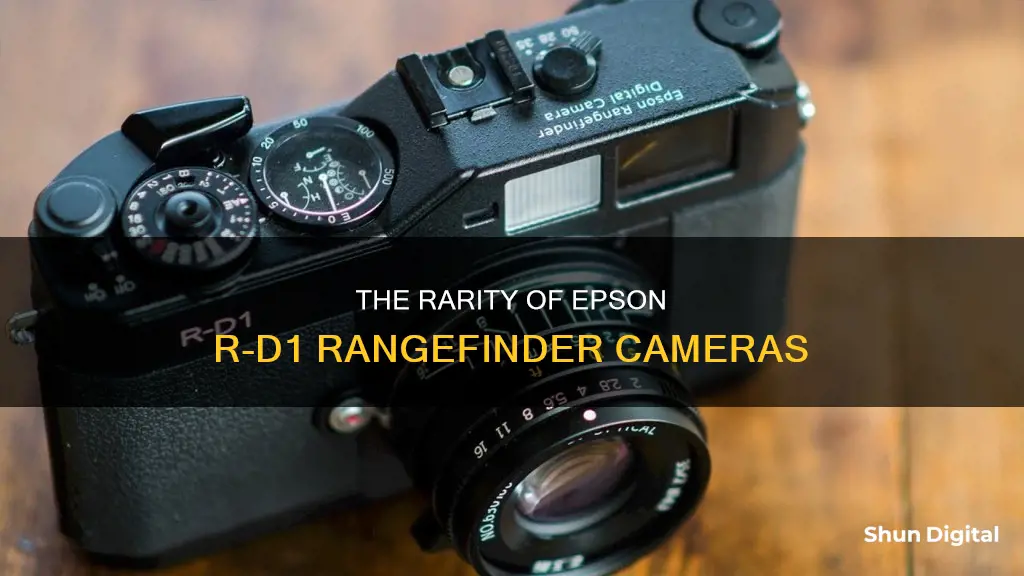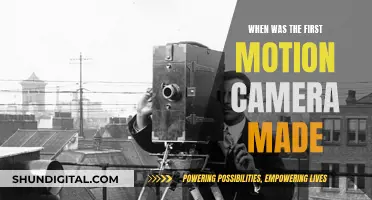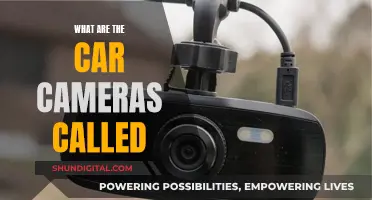
The Epson R-D1 was the world's first digital rangefinder camera. Introduced in 2004, the camera was developed in partnership with Cosina, the parent company of the modern Voigtlander brand. The R-D1 was manufactured by Cosina, which also builds the current Voigtlander cameras. The camera was discontinued in 2007, and three modifications of the original R-D1 were subsequently produced - the R-D1s, R-D1x, and R-D1xG.
| Characteristics | Values |
|---|---|
| Announcement date | March 2004 |
| Discontinuation date | 2007 |
| Manufacturer | Seiko Epson and Cosina |
| Mount | Leica M-mount lenses or earlier Leica screw mount lenses with an adapter |
| Shutter | Manually wound with a rapid wind lever |
| Sensor | 6.1 megapixel APS-C CCD (23.7 x 15.6 mm); Max. resolution 3008 x 2000 |
| ISO | 200, 400, 800, 1600 |
| LCD Screen | 2" 235,000 dots |
| Shutter speed | Max speed 1/2000 second |
| Storage | SD card (2GB max) |
| Dimensions | 142 x 89 x 40 mm |
| Weight | 610 grams (1.37 lb) |
What You'll Learn

The Epson R-D1 was the world's first digital rangefinder camera
The Epson R-D1 is a digital rangefinder camera introduced by Epson in 2004. It is the world's first digital rangefinder camera.
The R-D1 was jointly developed by Seiko Epson and Cosina and manufactured by the latter. The camera body was based on the Voigtlander Bessa R series of film cameras. It uses Leica M-mount lenses or earlier Leica screw-mount lenses with an adapter.
The R-D1 sports a 6.1-megapixel APS-C sensor with a 1.5x crop factor. An interesting feature of the camera is its manually wound shutter with a rapid wind lever, similar to film-based rangefinder cameras.
The R-D1 was first announced by Epson in March 2004 and was discontinued in 2007. Subsequently, three modifications of the original R-D1 were produced: the R-D1s, R-D1x, and R-D1xG. The R-D1s added features such as noise reduction for long exposures and a firmware upgrade. The R-D1x and R-D1xG models offered a larger LCD display, support for higher-capacity SDHC memory cards, and improved accessibility of rangefinder adjustment.
The Epson R-D1 stands out for its unique design, incorporating vintage mechanical precision and tactile handling with a digital workflow. It provides a film camera-like experience, including a functional shutter-cocking lever and analogue dials displaying data such as white balance, shutter speed, and shots remaining.
The R-D1 has a dedicated following among photographers and camera collectors, with its uniqueness and film-like experience commanding high prices on the used market. It is considered a cult classic and a monument to beautiful, classic camera design, blending the traditional film camera experience with digital technology.
VTech Kidizoom Camera: What's in the Box?
You may want to see also

It was jointly developed by Seiko Epson and Cosina
The Epson R-D1, the world's first digital rangefinder camera, was jointly developed by Seiko Epson and Cosina Company, Ltd. Cosina, a Japanese camera and lens manufacturer, is based in Nakano, Nagano Prefecture, Japan. The company was founded in 1959 as a lens processing factory under the name Nikō (or "Nikoh"). In 1973, Nikō changed its name to Cosina.
Cosina has a long history of manufacturing optical glass and is known for making camera equipment for other brands. The company has produced cameras and lenses under its own name, but it is better known for manufacturing equipment for resale under other companies' brands. Cosina has manufactured camera bodies for well-known brands, including Canon, Nikon, Olympus, and Yashica.
In 2004, Epson announced the R-D1, the world's first digital rangefinder camera. The camera was jointly developed by Seiko Epson and Cosina, with the latter also manufacturing the R-D1. The R-D1 was based on the Voigtlander Bessa R series of film cameras, and it used Leica M-mount lenses or earlier Leica screw-mount lenses with an adapter.
The collaboration between Seiko Epson and Cosina resulted in a unique camera that combined digital technology with a film-like experience. The R-D1 featured a manually wound shutter, analog dials, and a large viewfinder, offering a tactile and intuitive shooting experience reminiscent of film cameras.
Latest Camera Raw Update: New Features and Improvements
You may want to see also

The R-D1 has a unique manually wound shutter
The Epson R-D1, the first digital rangefinder camera, has a unique manually wound shutter. This feature is unusual for a digital camera, as it requires manually winding a lever to cock the shutter, mimicking the controls of a film-based rangefinder camera. The R-D1 was jointly developed by Seiko Epson and Cosina and manufactured by the latter.
The manually wound shutter gives the R-D1 a distinctive quality that sets it apart from other digital cameras. To operate the shutter, users must physically wind a lever, a feature typically associated with traditional film cameras. This gives the camera a retro feel that blends old-school mechanics with modern digital technology.
The R-D1's manually wound shutter is not just a design choice but also serves a practical purpose. By incorporating this feature, the camera provides users with a tactile, hands-on experience that harkens back to the days of film photography. It adds a layer of interactivity and a sense of mechanical precision to the act of taking photographs.
The shutter speed settings on the R-D1 range from one second to 1/2000 seconds, offering a versatile range for photographers to work with. Additionally, the camera features a rapid wind lever, making the process of winding the shutter quick and efficient, ensuring that photographers can capture spontaneous moments without delay.
The R-D1's manually wound shutter is a testament to the camera's unique design philosophy, blending nostalgia for analogue cameras with the conveniences of digital technology. It offers a different kind of interaction between the photographer and the camera, adding a physical, mechanical element to the digital imaging process.
Unveiling Camera Raw Panel in Bridge: A Step-by-Step Guide
You may want to see also

The R-D1 was discontinued in 2007
The Epson R-D1 was discontinued in 2007, just three years after its launch in 2004. The R-D1 was the world's first digital rangefinder camera, and it took the camera world by surprise. Almost no one saw it coming, and the camera was especially notable because it was not released by Leica, a company synonymous with rangefinder cameras.
The R-D1 was jointly developed by Seiko Epson and Cosina and manufactured by the latter. It was based on the Voigtlander Bessa R series of film cameras and used Leica M-mount lenses. The R-D1 featured a manually wound shutter with a rapid wind lever, and its controls operated in the same way as film-based rangefinder cameras. The camera also featured analogue dials, made by Seiko, that displayed information such as shots remaining, white balance, and image quality.
Despite its innovative design and features, the R-D1 was ultimately discontinued. While the exact reasons for its discontinuation are not clear, it is possible that the camera's high price tag and the emergence of more advanced digital cameras contributed to its demise. Additionally, Epson may have struggled to compete with Leica, which released its own digital rangefinder camera, the M8, in 2006.
Following the discontinuation of the R-D1, Epson released three modifications of the original model: the R-D1s, R-D1x, and R-D1xG. These modified versions offered improvements such as noise reduction for long exposures, larger LCD displays, and support for higher-capacity memory cards. However, these subsequent models failed to revive the success of the original R-D1, and Epson eventually discontinued the R-D1 line altogether in 2014.
GoPro Charging Time: How Long Until Your Camera's Ready?
You may want to see also

Three subsequent models were released: the R-D1s, R-D1x, and R-D1xG
The Epson R-D1, the world's first digital rangefinder camera, was first introduced in 2004. Subsequently, three modifications of the original R-D1 were produced: the R-D1s, the R-D1x, and the R-D1xG.
The R-D1s was released in March 2006 and is mechanically identical to the R-D1 but with a firmware upgrade. The upgrade includes noise reduction for long exposures, and a JPEG + Raw mode and a quick view function. The original R-D1 could be upgraded to have these features via a firmware update.
The R-D1x and R-D1xG were released in April 2009 and were only made available in Japan. They feature a larger 2.5" LCD display, support for SDHC memory cards (up to 32 GB), and improvements in the accessibility of rangefinder adjustment. The R-D1xG model also includes a removable grip. The LCD on these models is no longer articulated and cannot be closed.
All models of the Epson R-D1, including the subsequent releases, use the same 1.5x crop factor sensor, interline-transfer CCD (Sony ICX413AQ). This is the same sensor used in the Pentax *ist D and Nikon D100, dating back to 2002.
Unlocking Camera Raw: Preview Power
You may want to see also
Frequently asked questions
The Epson R-D1 was announced in March 2004 and discontinued in 2007.
It is unclear how many units of the Epson R-D1 were manufactured. However, the camera is considered a cult classic and highly sought-after by collectors.
The Epson R-D1 was the world's first digital rangefinder camera, offering a unique blend of vintage design and digital functionality. It features a 6.1-megapixel APS-C sensor, a Leica M mount, and a manually wound shutter with a rapid wind lever.
The Epson R-D1 was developed jointly by Seiko Epson and Cosina, with the latter also being responsible for the camera's manufacturing.
The Epson R-D1 features a 6-megapixel APS-C CCD sensor, ISO settings from 200 to 1600, a 2" LCD screen with 235,000 dots, a maximum shutter speed of 1/2000 second, and SD card storage with a 2GB maximum capacity.







